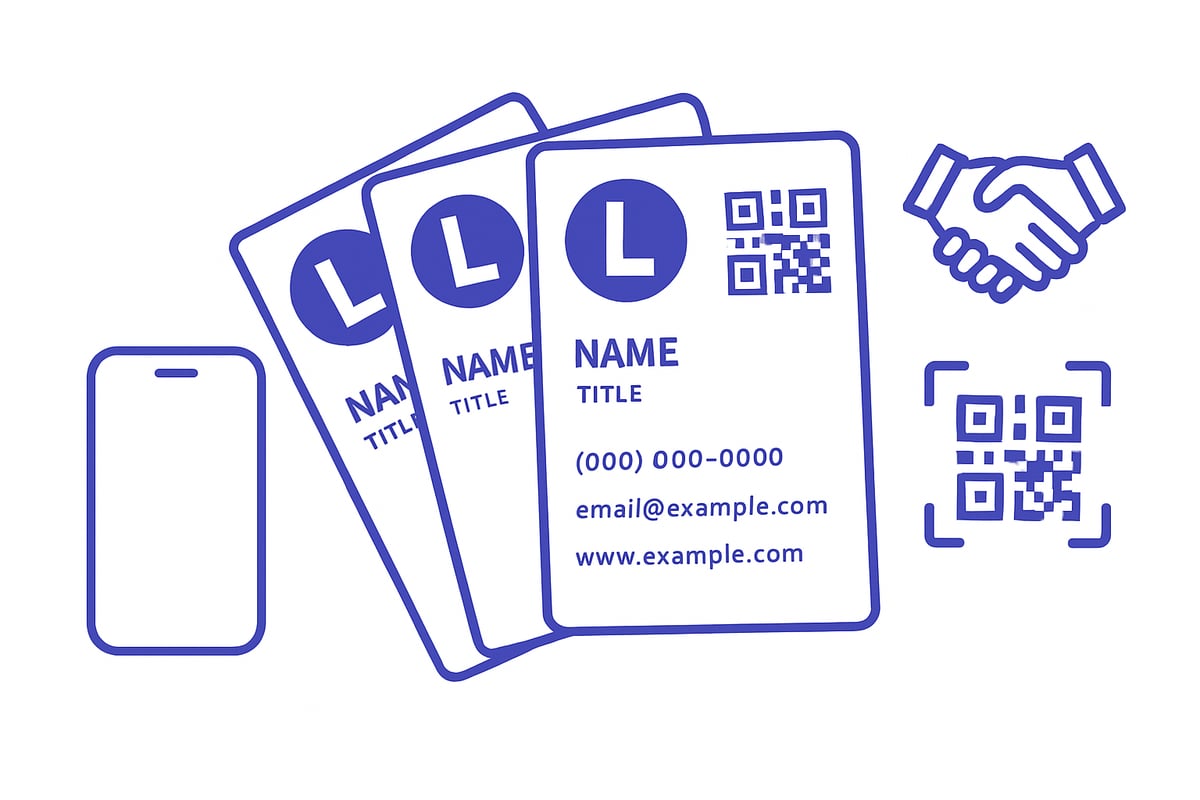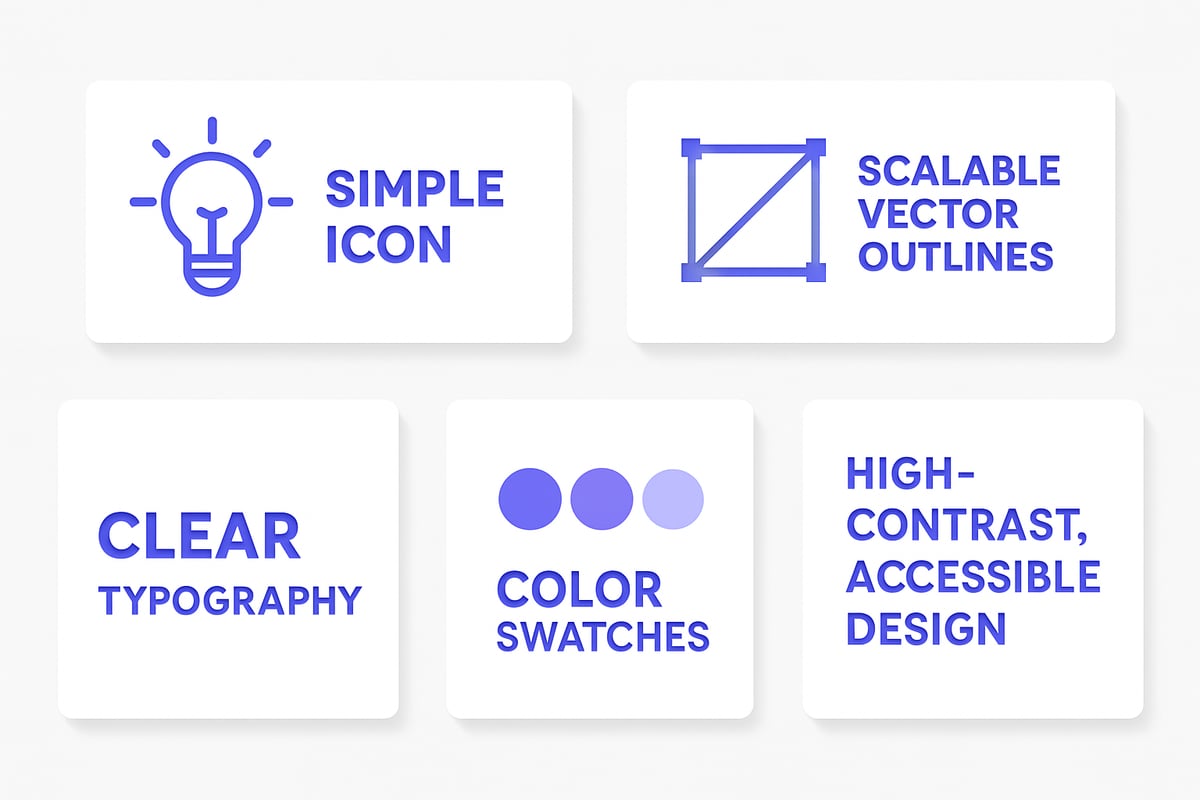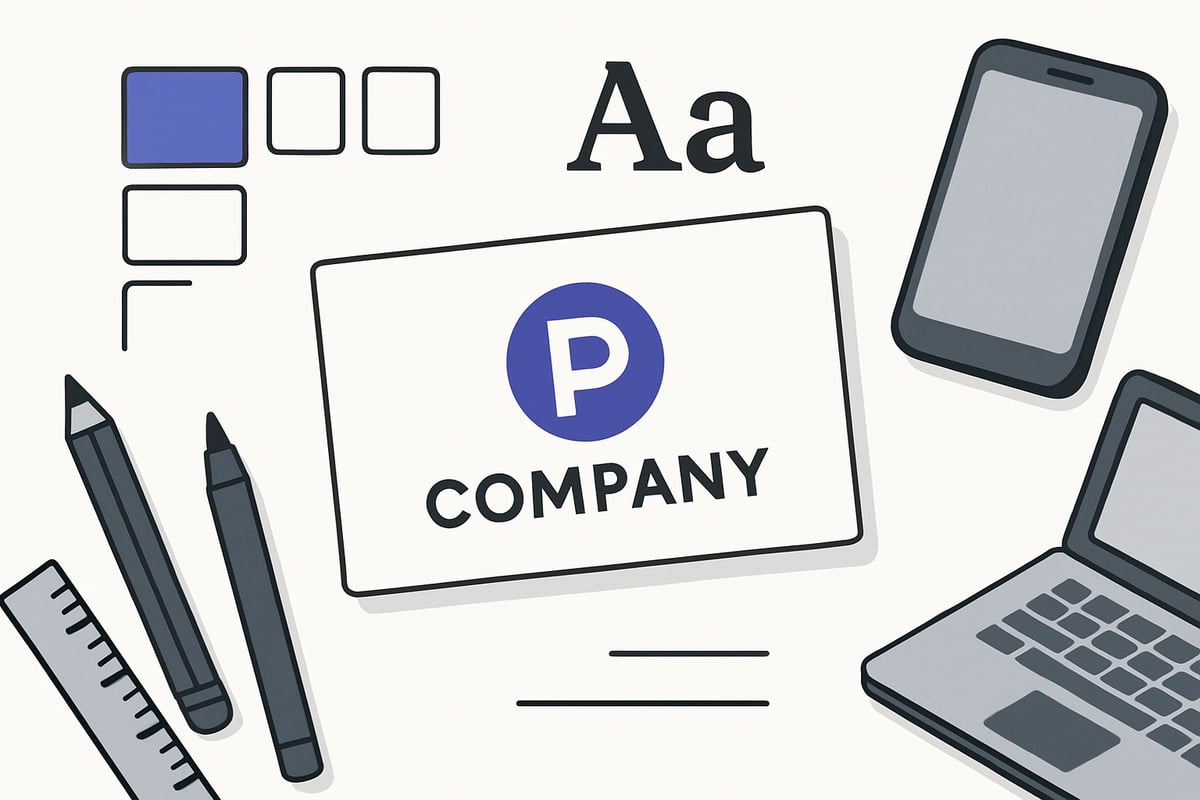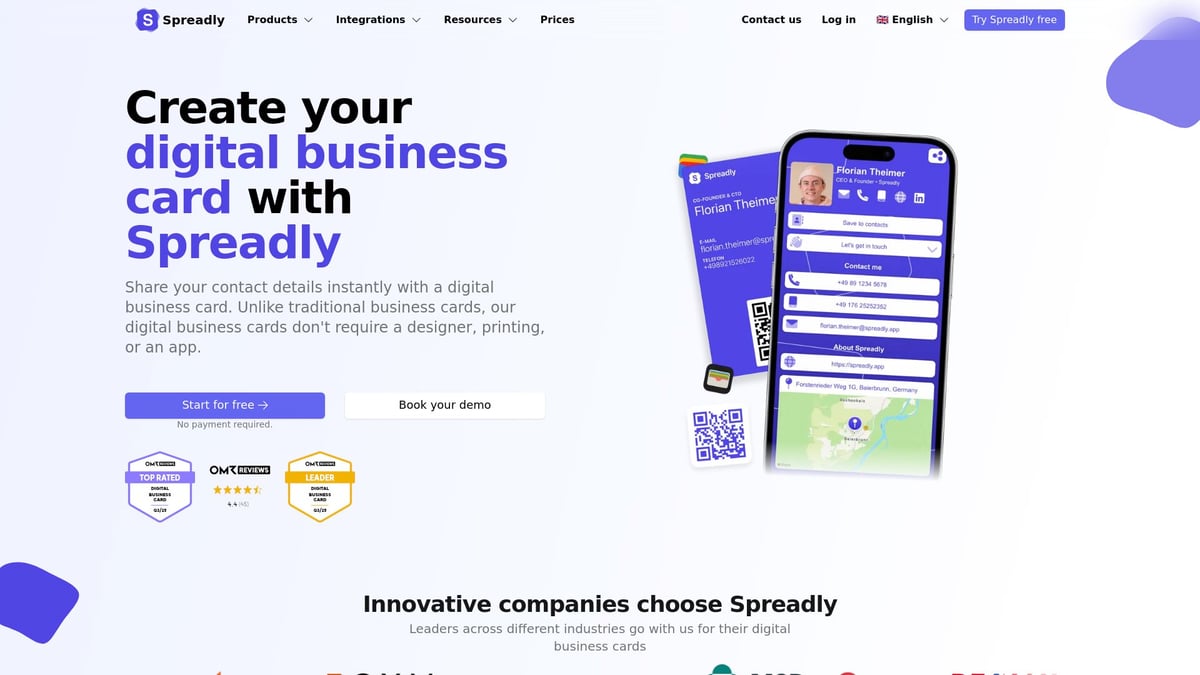Business Card Logo Design Guide for 2025 Success
14 minutes
11th of October 2025
In this article:
- The Importance of Business Card Logo Design in 2025
- Key Principles of Effective Business Card Logo Design
- Step-by-Step Guide: Designing Your Business Card Logo for 2025
- Business Card Logo Design Trends to Watch in 2025
- Integrating Your Logo Seamlessly into Business Card Designs
- Expert Tips for Business Card Logo Success in 2025
In 2025's fast-evolving business world, a powerful business card logo design is your secret weapon for making a lasting first impression. With networking becoming increasingly digital and competitive, your logo can set you apart from the crowd.
This comprehensive guide is crafted to help professionals and businesses master business card logo design for standout results. You'll discover the latest trends, essential design principles, and a clear step-by-step process for creating memorable logos.
Ready to elevate your brand? Dive in for expert tips, actionable strategies, and the insights you need to ensure your business card logo design drives success in 2025.
The Importance of Business Card Logo Design in 2025
A compelling business card logo design is more than a visual flourish—it's a strategic tool for building connections in 2025. As professional networking evolves, the logo on your card becomes a silent ambassador for your brand, shaping first impressions and driving engagement in every interaction.

The Evolving Role of Business Cards
Business cards have transformed into hybrid tools bridging digital and physical networking. In a post-pandemic world, professionals rely on cards not just for contact sharing, but as gateways to digital profiles and portfolios. Despite this evolution, 88% of business cards are discarded within a week, making the business card logo design essential for leaving a lasting mark. Industries like real estate, consulting, and creative services still see high value in business cards, especially when in-person meetings remain crucial for trust-building.
Why Logos Are Central to Brand Identity
A thoughtfully crafted business card logo design acts as an instant identifier for your brand. Logos leverage psychological triggers, helping recipients recall your business long after a brief meeting. Maintaining logo consistency across print and digital assets reinforces brand recognition and trust. Minimalist cards featuring iconic logos, such as those from tech or fashion brands, demonstrate how visual simplicity can enhance memorability and perceived professionalism.
Trends Shaping Business Card Logos in 2025
Emerging trends in business card logo design for 2025 include minimalism, bold color choices, and adaptive layouts. Integration with QR codes and digital touchpoints is now standard, allowing seamless transitions between print and online experiences. The demand for interactive, scannable cards continues to rise, with some businesses even introducing animated logos for digital business cards. For a deeper dive into these trends, see the Top Business Card Trends for 2025.
The Impact of a Strong Logo on Networking Outcomes
A robust business card logo design directly influences engagement and follow-up rates. Logos can spark conversations, making it easier to break the ice and form connections. In one notable case, a company that refreshed its logo saw a significant uptick in networking leads and meetings booked. A unique, well-placed logo not only draws attention but also signals credibility and professionalism, leading to more meaningful interactions.
Common Mistakes and Missed Opportunities
Many professionals undermine their business card logo design by opting for overly complex visuals or neglecting scalability. A logo that looks impressive on screen may lose clarity when printed small. Readability and accessibility are often overlooked, which can alienate potential contacts. Failing to design with inclusivity in mind means missing out on 38% more engagement that well-designed logos typically deliver, according to industry reports.
Key Principles of Effective Business Card Logo Design
Creating a strong business card logo design in 2025 means mastering a handful of essential principles. These guidelines ensure your logo is both visually compelling and functionally effective across all networking scenarios. Let’s break down each principle so your business card logo design stands out from the rest.

Simplicity and Memorability
The best business card logo design is often the simplest. Simple logos are easier for clients to remember, recognize, and recall during follow-up conversations. Think of iconic brands like Apple or Nike—their logos are instantly recognizable because they strip away anything unnecessary.
To achieve this, focus on:
- Reducing your design to its core elements
- Avoiding unnecessary details or clutter
- Choosing shapes and symbols that reflect your brand’s essence
A memorable business card logo design is a powerful tool for brand recall, especially in fast-paced networking environments.
Scalability and Versatility
Your business card logo design must look sharp and clear at any size. A logo that works on a billboard might lose impact on a small card if not designed properly. Use vector graphics, which scale without losing quality, instead of raster images that can appear pixelated.
Tips for ensuring versatility include:
- Testing your logo at different sizes, from tiny card icons to digital banners
- Designing with both print and digital uses in mind
- Maintaining strong contrast for better visibility
A versatile business card logo design adapts seamlessly across business cards, websites, and merchandise.
Color Psychology and Brand Alignment
Color choice in business card logo design can influence perception and set the tone for your brand. In 2025’s multicultural market, colors like blue signal trust, green suggests growth, and red conveys energy. Align your color palette with your brand values and your industry’s expectations.
Consider this simple color psychology table:
| Color | Meaning | Common Industry Use |
|---|---|---|
| Blue | Trust, Calm | Finance, Tech |
| Green | Growth, Health | Sustainability, Wellness |
| Red | Energy, Action | Retail, Food |
| Black | Luxury, Power | Fashion, Consulting |
Selecting the right colors helps your business card logo design resonate with your target audience and ensures a consistent brand experience.
Typography and Readability
Typography gives your business card logo design its personality. The right font should reflect your brand’s character while ensuring maximum readability. Custom typefaces and variable fonts are trending in 2025, offering unique style without sacrificing clarity.
When choosing typography:
- Prioritize legibility at small sizes
- Balance style with function
- Pair fonts for hierarchy and emphasis
For further inspiration on integrating unique typography into your business card logo design, explore Designs That Impress and Inspire: Top Business Card Trends of 2025.
Accessibility and Inclusivity
An effective business card logo design must be accessible to all. Design for color blindness by using high-contrast color combinations and avoid relying solely on color to communicate meaning. Ensure your logo remains clear for those with visual impairments by testing it in grayscale.
Best practices include:
- Using textures or patterns in addition to color
- Ensuring sufficient contrast between logo and background
- Creating alternative versions for different accessibility needs
Inclusive business card logo design allows your brand to connect with a broader, more diverse audience.
Step-by-Step Guide: Designing Your Business Card Logo for 2025
A successful business card logo design requires a systematic approach tailored to 2025’s evolving landscape. Follow these essential steps to create a logo that not only stands out but also delivers lasting brand impact.

Step 1: Define Your Brand Identity
Start your business card logo design journey by clarifying your brand’s mission, vision, and core values. Understand what your business stands for and how you want to be perceived. Identify your target audience and research key competitors to position your brand uniquely in the market.
Create a brand mood board with colors, images, and keywords that reflect your personality. This foundational step ensures every design choice aligns with your overarching brand identity. When your business card logo design is rooted in a clear brand narrative, it becomes a powerful tool for recognition and trust.
Step 2: Research Trends and Inspiration
To create a forward-thinking business card logo design, analyze competitor logos and examine industry leaders. Explore global design trends for 2025, focusing on minimalism, adaptive elements, and digital integration. Use platforms like Pinterest and Behance to gather diverse visual inspiration.
Stay updated on emerging innovations, such as creative QR codes and tactile finishes, by referencing industry resources like 9 Innovative Business Card Trends for 2025. This research ensures your business card logo design remains current and relevant in a competitive landscape.
Step 3: Choose Your Logo Style and Elements
Select the logo type that best suits your brand’s message. Common styles include wordmarks, lettermarks, emblems, abstract symbols, and pictorial marks. Consider which format communicates your identity most effectively and resonates with your audience.
For your business card logo design, choose icons, motifs, or illustrations that capture your essence. Minimalist logos offer timeless appeal, while illustrative designs can convey creativity. Compare options to find the perfect balance between simplicity and uniqueness, ensuring your logo stands out across all touchpoints.
Step 4: Select Colors and Typography
Apply color theory to align your business card logo design with your brand values and industry norms. Select a color palette that evokes the right emotions—such as blue for trust or green for growth. Use tools like Adobe Color to experiment with combinations.
Pair fonts that enhance hierarchy and readability. Choose typography that reflects your brand’s personality, whether it’s modern and bold or classic and refined. Google Fonts offers a wide selection to support your business card logo design, ensuring your text remains clear and impactful.
Step 5: Draft, Refine, and Iterate
Begin your business card logo design process with quick sketches to explore ideas. Move to digital mockups for a more polished view, using design software to refine shapes and spacing. Gather feedback from peers, clients, or mentors at each stage to identify strengths and areas for improvement.
Iterate your designs, making adjustments based on constructive input. This collaborative approach strengthens your business card logo design, ensuring it meets both aesthetic and strategic goals before moving to finalization.
Step 6: Test Scalability and Versatility
A robust business card logo design must perform well at all sizes and on various backgrounds. Print your logo in different dimensions to check for clarity and legibility. Test how it appears on dark and light backgrounds, as well as in grayscale.
Ensure your logo remains crisp in digital formats like PNG and SVG. Versatility is crucial for business card logo design, as your logo will appear across print, digital, and merchandise. Confirm adaptability to guarantee consistent impact everywhere it’s seen.
Step 7: Finalize, Export, and Implement
Once satisfied, export your business card logo design in all essential file formats (AI, SVG, PNG, PDF) to accommodate diverse use cases. Integrate your finalized logo into business card layouts, ensuring proper alignment and visual harmony with other card elements.
Use a checklist to validate consistency across platforms—print, digital, and beyond. A well-prepared business card logo design accelerates brand recognition, enabling seamless rollout across all professional touchpoints.
Business Card Logo Design Trends to Watch in 2025
Staying ahead in business card logo design means understanding the trends shaping professional impressions in 2025. As the landscape evolves, logos must adapt to new technologies, sustainability demands, and diverse audiences. Below, we explore the five most influential trends redefining how business card logo design delivers impact and memorability.
Minimalism and Negative Space
Minimalism continues to dominate business card logo design, emphasizing clarity and instant recognition. Clean lines, ample whitespace, and subtle negative space create logos that stand out without distraction. Designers leverage hidden imagery within negative space, as seen in the FedEx and WWF logos, to add meaning and intrigue.
Simple layouts not only enhance visual appeal but also improve recall and scalability. For those seeking inspiration, Business Card Design Trends 2025 – Latest Stylish Ideas offers a comprehensive overview of how minimalism shapes modern business cards. This approach ensures your business card logo design remains timeless and effective in fast-paced networking environments.
Animated and Interactive Logos
Digital transformation fuels the rise of animated and interactive logos in business card logo design. Motion graphics and subtle animations breathe life into digital business cards, creating memorable first impressions. QR codes and NFC technology allow instant access to portfolios or contact information, making networking seamless.
Recent surveys reveal that 55% of professionals prefer interactive business cards. Animated logos not only engage recipients but also showcase innovation and adaptability. Incorporating these features into your business card logo design helps bridge the gap between physical and virtual interactions, ensuring your brand stays relevant in a digital-first era.
Sustainable and Eco-Friendly Design
Sustainability is now central to business card logo design, reflecting a brand’s commitment to environmental responsibility. Designers favor earthy color palettes, recycled materials, and minimalist graphics to signal eco-conscious values. Logos often incorporate natural motifs or green accents, resonating with audiences who prioritize sustainability.
In industries focused on environmental impact, such as renewable energy and organic products, eco-friendly business card logo design has become a competitive differentiator. Choosing sustainable materials and thoughtful design not only reduces waste but also strengthens your brand’s ethical reputation and appeal.
Customization and Personalization
Personalization is transforming business card logo design, enabling brands to express individuality and connect authentically. Variable fonts, adaptive colorways, and AI-driven customization tools allow for tailored logos that reflect each professional’s unique identity.
Freelancers, startups, and large corporations alike benefit from business card logo design that adapts to context and audience. Personalized logos foster stronger relationships and boost memorability. This trend encourages experimentation, letting brands stand out in crowded markets while maintaining consistency across platforms.
Inclusive and Accessible Design
Inclusivity is a cornerstone of effective business card logo design in 2025. Brands prioritize accessibility by designing logos that are legible for all, including those with visual impairments or color blindness. High-contrast color combinations and culturally adaptive elements ensure universal appeal.
Multilingual logos and symbols resonate with diverse, global audiences. Industry reports show that 70% of brands now make inclusivity a top design priority. By embracing accessible business card logo design, you demonstrate respect for every client and partner, fostering trust and broadening your network.
Integrating Your Logo Seamlessly into Business Card Designs
A seamless business card logo design elevates your networking impact. Integration is more than just placing a logo—it’s about harmonizing every element for a polished, memorable result. Let’s explore how to maximize your logo’s presence on business cards, both physical and digital.
Placement and Sizing Best Practices
Proper placement and sizing are critical for effective business card logo design. Position your logo where it draws attention without overpowering contact details. The upper left corner and center are popular choices, each offering distinct visual hierarchy.
Balance logo size to avoid clutter. A logo that’s too large overshadows other elements, while one that’s too small can be overlooked. Consider how whitespace enhances readability and elegance. Test different arrangements to discover what works best for your brand.
Harmonizing Logo with Card Layout
To achieve a cohesive business card logo design, align your logo with the card’s overall layout. Use grid systems to maintain balance between logo, text, and whitespace. This approach ensures information is easy to find and visually appealing.
A harmonious layout guides the recipient’s eye from your logo to essential details. Consistency in spacing and alignment reinforces professionalism. Always preview your design in both horizontal and vertical orientations for versatility.
Matching Logo Style to Card Material and Finish
The choice of material and finish can dramatically influence your business card logo design. Matte, gloss, embossing, and foil each interact with logos in unique ways. For tactile impact, raised ink or embossing makes logos pop and adds sophistication.
Select card materials that complement your logo’s color and style. Earthy textures work well for eco-conscious brands, while glossy finishes enhance vibrant logos. Always request print proofs to evaluate how finishes affect logo clarity and appeal.
Digital and NFC Business Cards: Logo Considerations
Digital platforms demand adaptability in business card logo design. Ensure your logo remains sharp on screens of all sizes and retains its identity in animated or interactive formats. Test logos in both static and motion versions for digital wallet compatibility.
For NFC-enabled cards, clarity is paramount. Simplified logos load quickly and display well on mobile devices. Consider how your logo integrates with QR codes or tap-to-share features to create seamless digital experiences for recipients.
Digital Business Card Solutions: Modernizing Logo Use
Modern digital business card solutions like Spreadly revolutionize logo integration. Instantly update business card logos across all users—no need for costly reprints. Rich media support allows for animated logos, custom fonts, and interactive backgrounds that boost engagement.

Spreadly’s platform enables seamless CRM and HR integration for enterprise branding. Digital cards are eco-friendly and offer real-time updates, ensuring your brand always looks current. Leading organizations leverage these features for a cohesive, professional image in every interaction.
Expert Tips for Business Card Logo Success in 2025
Mastering business card logo design in 2025 requires more than just creative flair. The following expert tips will help ensure your logos stand out, remain relevant, and drive real business results.
Collaborate with Professional Designers or Use AI Tools
When considering business card logo design, collaboration with professionals is invaluable. Expert designers bring experience, originality, and a deep understanding of branding. They can interpret your brand’s story and translate it into an impactful logo.
Alternatively, AI-powered logo makers offer affordable and rapid solutions. Platforms like Fiverr, 99designs, and Wix Logo Maker provide access to both human talent and smart design algorithms. Whether hiring a designer or using AI, always ensure the result aligns with your brand’s identity and stands out from competitors.
Prioritize Consistency Across All Brand Touchpoints
Consistency is crucial for effective business card logo design. Your logo should appear identically across all platforms—business cards, websites, social media, and merchandise. This unified presence builds trust and fosters instant recognition.
Develop a comprehensive brand style guide. Specify logo usage, color palettes, and spacing rules. Leading brands maintain this consistency, ensuring their business card logo design remains professional and memorable, regardless of the medium.
Leverage Feedback and Iterative Improvement
Continuous improvement is a cornerstone of successful business card logo design. Seek feedback from clients, colleagues, and even potential customers. Use surveys, direct conversations, or digital analytics to gather insights.
A/B testing different logo variations can reveal which designs perform best. Embrace an iterative process—refine your logo based on real-world engagement data. This approach ensures your business card logo design evolves to meet changing audience expectations and increases its impact over time.
Keep Up with Evolving Design Trends and Technologies
Staying current is essential in business card logo design. Subscribe to design blogs, attend webinars, and follow industry leaders to monitor emerging trends like AR, VR, and digital wallet integration.
Regularly update your logo to ensure compatibility with new formats and networking platforms. By proactively adapting, your business card logo design remains fresh, relevant, and ready for the future of professional networking.
As you’ve seen throughout this guide, the right business card logo can make a lasting impression and open doors in 2025’s dynamic networking landscape. Whether you’re refining your brand identity or adopting the latest in digital card technology, taking action now can set you apart from the competition. With Spreadly, you can instantly create, update, and share a modern, interactive business card—no design experience needed. Ready to bring your new logo to life and start making stronger connections? You can try for free and experience firsthand how easy it is to elevate your brand.






